A properly cooked dry aged ribeye recipe is more than just a dish—it’s an unforgettable ritual of flavor, fire, and finesse. This guide is your go-to blueprint for making the ultimate steak at home, with two distinct methods: cast iron for crust lovers, and grilling for smoky, bold flavor. Along the way, you’ll learn about seasoning choices, temperature precision, and pro techniques that turn a beautiful cut into a masterpiece. Whether you’re a purist or a flavor chaser, you’re about to experience steak perfection.
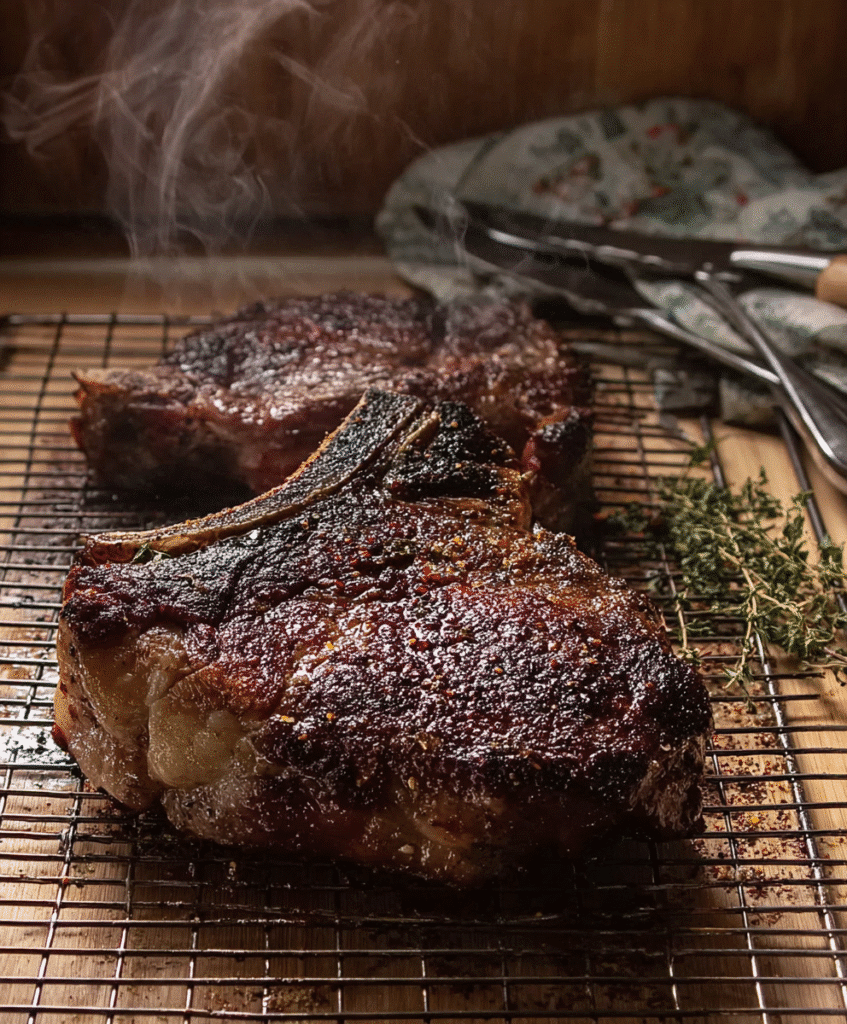
Part 1: Why Dry Aged Ribeye Is Worth the Hype (And How to Cook It Right)
The Flavor Memory That Sparked My Obsession
The first time I tasted a dry aged ribeye, I didn’t just eat it—I remembered it. It was at a backyard cookout where the host pulled this marbled masterpiece off the grill and sliced it, revealing an edge-to-edge medium-rare pink with a crust that crackled. That flavor—nutty, deeply beefy, intense—rewired how I thought about steak. It reminded me of why I started Recent Recipe in the first place: to bring unforgettable flavors to your kitchen, grounded in simplicity and passion. And now, I’m bringing that experience to your plate with this dry aged ribeye recipe.
What makes this cut so special? The dry aging process naturally tenderizes the meat and concentrates its flavor. It evaporates moisture, breaks down enzymes, and builds that signature funk steak lovers chase. This isn’t just dinner—it’s steak in its highest form. And cooking it doesn’t need to be complicated. In fact, the simpler your method, the more the meat shines.
Whether you choose the cast iron approach indoors or flame-grilled outdoors, this dry aged ribeye recipe delivers bold, consistent results every time. You’ll learn how to get that amazing crust of salty flavors and juicy interior using the reverse sear method, whether in a preheated cast iron skillet or over a two-zone grill setup.
Understanding the Ritual of Cooking a Dry Aged Ribeye
If you rush it, you ruin it. That’s the core rule of dry aged beef. This dry aged ribeye recipe is built on patience and precision. Before you even touch the pan or grill, you’ll let the steak sit out and reach room temperature—this allows for even cooking and prevents tough muscle fibers from tensing under heat. Then comes the sear—a moment of flavor-locking magic where high heat creates a crust and butter basting infuses richness.
Another essential step? Resting. Too often skipped, this phase allows the juices to redistribute, giving you tender slices and no soggy plate puddles. Every element, from seasoning to timing, plays a role in transforming this cut into an experience.
This isn’t about complexity—it’s about respecting the process. The dry aged ribeye recipe below guides you through every step, grounded in technique and driven by flavor. You’ll also find tips from the pros, and a way to make this meal your signature dish—indoors or out.
And don’t worry, we’re answering all your steak questions at the end—from how long to dry age, to whether reverse searing is worth it (spoiler: it is).
Part 2: Two Foolproof Ways to Cook the Perfect Dry Aged Ribeye
Print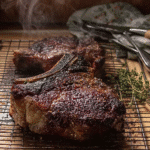
The Ultimate Dry Aged Ribeye Recipe (Cast Iron & Grill Methods)
- Total Time: 50 minutes
- Yield: 2 servings 1x
Description
Restaurant-worthy dry aged ribeye recipe using cast iron or grilling methods. Learn perfect seasoning, temps, and searing tips.
Ingredients
1 dry aged ribeye steak (1.5–2 inches thick)
Kosher salt
Black pepper
2 tbsp avocado or canola oil
2 garlic cloves
2 sprigs rosemary or thyme
2 tbsp butter
2 dried arbol chilis
1 tsp coriander seeds
1 tsp peppercorns
½ tsp fennel seeds
1 tbsp olive oil
Instructions
1. Remove steak from fridge 45 minutes before cooking.
2. Pat steak dry. Apply seasoning or rub of choice.
3. Preheat oven to 250°F and cast iron skillet inside.
4. Place steak on wire rack and cook to 110°F internal temp.
5. Transfer skillet to stovetop and heat high until smoking.
6. Sear steak 1–1.5 minutes each side.
7. Add butter, garlic, herbs and baste steak.
8. Alternatively, grill over indirect heat to 110°F, then sear over direct heat.
9. Rest steak on rack for 10 minutes.
10. Slice against the grain and serve.
Notes
Let steak rest after cooking to preserve juices. For smoky flavor, use wood chunks when grilling. Always check temperature with a meat thermometer.
- Prep Time: 10 minutes
- Cook Time: 40 minutes
- Category: Dinner
- Method: Grilled, Cast Iron
- Cuisine: American
Nutrition
- Serving Size: 8 oz
- Calories: 750
- Sugar: 0g
- Sodium: 580mg
- Fat: 54g
- Saturated Fat: 22g
- Unsaturated Fat: 30g
- Trans Fat: 0g
- Carbohydrates: 2g
- Fiber: 1g
- Protein: 60g
- Cholesterol: 180mg
Keywords: dry aged ribeye recipe, steakhouse ribeye, reverse sear steak
Indoor Method: Cast Iron for a Restaurant-Style Crust
Start with a well-ventilated kitchen and a preheated oven. Dry aged beef deserves a hot surface, and nothing performs better than a cast iron pan. This method is ideal for controlled searing and achieving that golden, salty crust from edge to edge.
Ingredients (Classic Style – The Purist’s Choice)
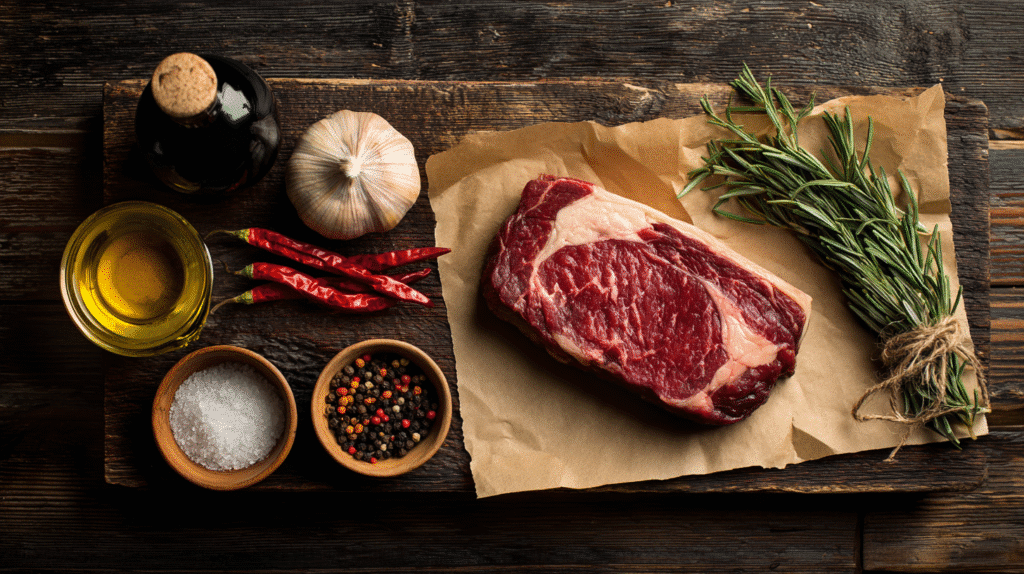
- 1 dry aged ribeye steak (1.5–2 inches thick, bone-in or boneless)
- Kosher salt
- Freshly ground black pepper
- 2 tbsp high-smoke-point oil (avocado or canola)
- 2 garlic cloves (smashed)
- 2 sprigs of rosemary or thyme
- 2 tbsp unsalted butter
Instructions – Cast Iron Method
- Remove steak from fridge 45 minutes before cooking to reach room temperature.
- Pat dry thoroughly with paper towels. Season all sides generously with salt and pepper.
- Preheat oven to 250°F and place steak on a wire rack over a baking sheet.
- Bake the steak in the oven until it reaches an internal temperature of 110°F for medium-rare doneness.
- Place a cast iron skillet over high heat and let it get piping hot until it begins to smoke
- Add oil and sear steak for 1–1.5 minutes per side.
- Add butter, garlic, and herbs. Baste the steak with melted butter for another 30 seconds.
- Rest steak on a wire rack for 10 minutes before slicing.
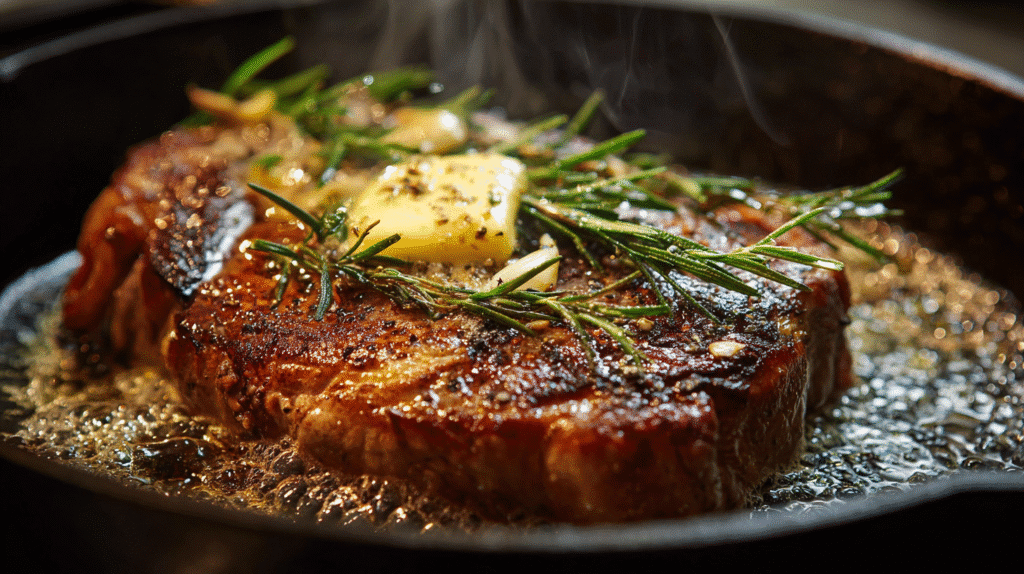
Outdoor Method: Two-Zone Flame Grilled Perfection
Want smokier vibes and fire-charred edges? This method is all about bold flavor. Use a two-zone grill setup with direct and indirect heat—perfect for dry aged beef.
Ingredients (Bold Wet Rub – The Adventurer’s Choice)
- 1 dry aged ribeye steak
- 2 dried arbol chilis
- 1 tsp coriander seeds
- 1 tsp black peppercorns
- ½ tsp fennel seeds
- 1 tsp coarse salt
- 1 tbsp olive oil
Instructions – Grill Method
- Toast arbol chilis and spices in a dry pan until fragrant. Let cool, then grind.
- Combine with salt and olive oil to make a wet rub. Coat steak generously.
- Let rest at room temp for 45 minutes.
- Set up your grill with a two-zone heat configuration, creating both direct and indirect cooking areas.
- Position the steak over the indirect heat zone, close the grill lid, and cook until the internal temperature reaches 110°F
- Move to direct heat and sear 1 minute per side for crust.
- Let steak rest 10 minutes before slicing.
Comparison Table: Cast Iron vs. Grill
| Méthode de cuisson | Idéale pour | Profil de saveur | Astuce de pro |
|---|---|---|---|
| Cast Iron + Four | Maîtrise en intérieur, croûte riche | Beurré, savoureux, style steakhouse | Préchauffer la poêle au four pendant 10 min |
| Barbecue au charbon ou gaz | Amateurs de saveur fumée en extérieur | Terreux, grillé, épices marquées | Ajouter des morceaux de bois pour infuser plus de fumée |
Both approaches give you the control needed for perfect medium rare, and the choice depends on your flavor mood—elegant butter or wild spice.
Part 3: Refine Your Dry Aged Ribeye Technique Like a Chef
How to Choose and Prep the Perfect Ribeye Cut
When you’re cooking a dry aged ribeye recipe, the cut matters just as much as the method. Start by choosing a well-marbled steak, ideally bone-in for flavor retention and dramatic presentation. Look for steaks aged 30 to 45 days, which offer intense beefiness without veering into overly funky territory. USDA Prime or Choice cuts with thick fat caps and visible marbling are your gold standard.
Once home, dry the surface thoroughly—moisture is your enemy when searing. Use paper towels and let the steak sit uncovered in the fridge for 12–24 hours to further dry out the surface. This is the secret to that coveted, crispy crust.
When you’re ready to cook, always let the steak come to room temperature. This prevents temperature shock and helps cook it evenly from edge to center. Never skip this step in your dry aged ribeye recipe—it ensures tenderness and keeps juices locked in.
Don’t Forget These Essential Prep Tips:
- Place your steak on a wire rack for even air circulation when resting or cooking in the oven.
- Trim excess fat if necessary, but leave enough for flavor and rendering.
- Season generously, but don’t over-marinate—let the meat shine.
The Ultimate Temperature & Doneness Chart
Precision is key when you’re working with a premium cut. Use an instant-read thermometer and pull your steak from the heat 5–7°F before your target temp, as it will continue cooking while resting.
Here’s your quick guide:
| Doneness | Pull at (°F) | Final Temp (°F) | Visual Cue |
|---|---|---|---|
| Rare | 115–120°F | 120–125°F | Cool red center |
| Medium Rare | 125–130°F | 130–135°F | Warm red center |
| Medium | 135–140°F | 140–145°F | Pink center |
| Medium Well | 140–150°F | 150–155°F | Faint pink center |
| Well Done | 155–160°F | 160°F+ | No pink, dry interior |
Important Tips for Cooking to Temperature:
- Slide the thermometer into the side of the steak to get the most precise temperature reading
- Let the steak rest on a wire rack, not a plate—this prevents sogginess.
- If cooking multiple steaks, check each individually—sizes vary.
With proper prep and a good thermometer, you’ll master any dry aged ribeye recipe like a seasoned pitmaster or chef.
Part 4: Expert Advice, Presentation Tips & Ideal Pairings
Pro-Level Tips for Perfect Results Every Time
You’ve selected the cut, mastered the method, and nailed the timing—but these expert strategies will take your dry aged ribeye recipe from impressive to unforgettable.
- Preheat cast iron in the oven at 500°F for 10 minutes before placing it on the burner—this ensures even heat distribution for a hard sear.
- Use high-smoke-point oil like avocado or grapeseed before adding butter to avoid burning.
- Don’t crowd the pan—searing multiple steaks together reduces crust quality.
- Add aromatics late—garlic, rosemary, or thyme should enter during the butter-basting stage to avoid scorching.
- Rest the steak on a wire rack to maintain its crust and allow the juices to redistribute without steaming the surface.
- Carve against the grain, always—this maintains texture and tenderness in every bite.
Apply these tips to both the grilled and cast iron methods, and you’ll deliver steakhouse results at home—every time.
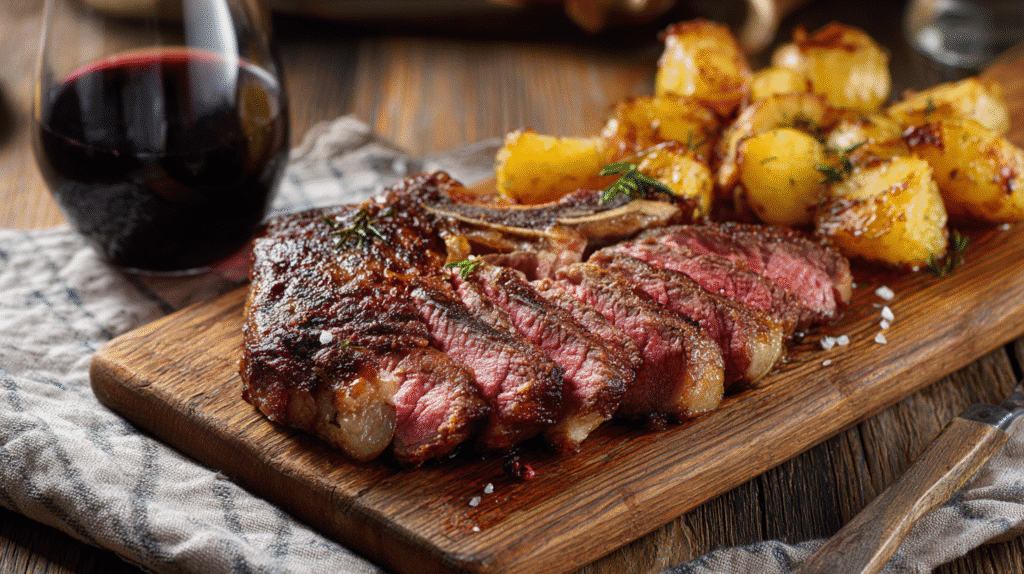
Serving the King of Steaks Like It Deserves
This steak doesn’t belong beside a microwaveable side or a bottled sauce. Pair your dry aged ribeye with flavors that elevate—not overpower—it.
Here are our ideal pairings:
- Sides
- Roasted garlic mashed potatoes with chive oil
- Charred broccolini with lemon zest
- Grilled sweet corn with smoked paprika butter
- Creamy mushroom risotto (if you want to impress)
- Sauces
- Red wine pan sauce
- Horseradish cream
- Chimichurri (for a bold, fresh bite)
- Drinks
- Wine: Cabernet Sauvignon, Syrah, or aged Bordeaux
- Beer: Stout or smoked porter
- Spirits: Smoked bourbon or a peppery rye whiskey
For dessert, round it out with something rich and elegant from our dessert collection, like a dark chocolate torte or brûléed banana pudding.
Dry aged steak is a celebration. Serve it like one.
Table of contents
Table of Contents
What’s the optimal technique for preparing a dry-aged ribeye steak?
The best method is a reverse sear—start low and slow in the oven or on the indirect side of a grill, then sear hot at the end to lock in crust and flavor. This gives you consistent doneness edge-to-edge.
How long does it take to dry-age ribeye?
Most dry-aged ribeyes are aged between 30 to 45 days, although some specialty cuts can go up to 90. Longer aging increases flavor complexity but also tenderness.
Is dry-aged ribeye worth it?
Yes—if you’re a steak lover. Dry-aged beef offers a more concentrated flavor and enhanced texture. It’s more expensive but provides a premium, steakhouse-style experience at home.
Should you reverse sear a dry aged steak?
Absolutely. It prevents overcooking and maximizes crust formation without drying out the interior. It’s especially valuable for thick, dry aged cuts.
There’s no single way to master a dry aged ribeye recipe—but with these two expert-approved methods, you’ve got the tools to become your own steakhouse. From selecting the cut to hitting the perfect temperature and pairing with bold sides, this guide delivers the complete steak experience.
Ready to take the challenge? Fire up the grill or heat that pan, and tag your ribeye creations on social media using #recentrecipe. Want to try something new next time? Explore more creative dinner ideas in our dinner section and keep building your culinary playbook.







